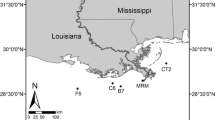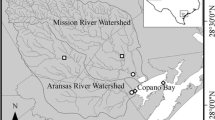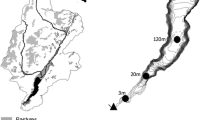Abstract
We examined the hydrologic controls on nitrogen biogeochemistry in the hyporheic zone of the Tanana River, a glacially-fed river, in interior Alaska. We measured hyporheic solute concentrations, gas partial pressures, water table height, and flow rates along subsurface flowpaths on two islands for three summers. Denitrification was quantified using an in situ 15NO −3 push–pull technique. Hyporheic water level responded rapidly to change in river stage, with the sites flooding periodically in mid−July to early−August. Nitrate concentration was nearly 3-fold greater in river (ca. 100 μg NO −3 –N l−1) than hyporheic water (ca. 38 μg NO −3 –N l−1), but approximately 60–80% of river nitrate was removed during the first 50 m of hyporheic flowpath. Denitrification during high river stage ranged from 1.9 to 29.4 mg N kg sediment−1 day−1. Hotspots of methane partial pressure, averaging 50,000 ppmv, occurred in densely vegetated sites in conjunction with mean oxygen concentration below 0.5 mgO2 l−1. Hyporheic flow was an important mechanism of nitrogen supply to microbes and plant roots, transporting on average 0.41 gNO −3 –N m−2 day−1, 0.22 g NH +4 –N m−2 day−1, and 3.6 g DON m−2 day−1 through surface sediment (top 2 m). Our results suggest that denitrification can be a major sink for river nitrate in boreal forest floodplain soils, particularly at the river-sediment interface. The stability of the river hydrograph and the resulting duration of soil saturation are key factors regulating the redox environment and anaerobic metabolism in the hyporheic zone.











Similar content being viewed by others
References
Addy K, Kellogg DQ, Gold AJ, Groffman PM, Ferendo G, Sawyer C (2002) In situ push–pull method to determine ground water denitrification in riparian zones. J Environ Qual 31:1017–1024
Anderson GS (1970) Hydrologic Reconnaisance of the Tanana River Basin, Central Alaska. USGS. Hydrological Investigations HA-319 Tanana Geology
Arendt AA, Echelmeyer KA, Harrison WD, Lingle CS, Valentine VB (2002) Rapid wastage of Alaska glaciers and their contribution to rising sea level. Science 297:382–386
Baker MA, Vervier P (2004) Hydrological variability, organic matter supply and denitrification in the Garonne River ecosystem. Freshw Biol 49:181–190
Baker MA, Dahm CN, Valett HM (1999) Acetate retention and metabolism in the hyporheic zone of a mountain stream. Limnol Oceanogr 44:1530–1539
Boulton AJ, Findlay S, Marmonier P, Stanley EH, Valett HM (1998) The functional significance of the hyporheic zone in streams and rivers. Annu Rev Ecol Syst 29:59–81
Chubarova NP (1972) Computation of the height of capillary rise of water in different genetic types of bound soils. Soil Mech Found Eng 9:25–27
Dahm CN, Carr DL, Coleman RL (1991) Anaerobic carbon cycling in stream ecosystem. Int Ver Theor Angew Limnol Verh 24:1600–1604
Dahm CN, Grimm NB, Marmonier P, Valett HM, Vervier P (1998) Nutrient dynamics at the interface between surface waters and groundwaters. Freshw Biol 40:427–451
Das BM (2002) Principles of geotechnical engineering, 5th edn. Brooks/Cole, Pacific Grove, California
Devito KJ, Fitzgerald D, Hill AR, Aravena R (2000) Nitrate dynamics in relation to lithology and hydrologic flow path in a river riparian zone. J Environ Qual 29:1075–1084
Duff JH, Triska FJ (1990) Denitrification in sediments from the hyporheic zone adjacent to a small forested stream. Can J Fish Aquat Sci 47:1140–1147
Duff JH, Triska FJ (2000) Nitrogen biogeochemistry and surface-subsurface exchange in streams. In: Jones JB Jr, Mulholland PJ (eds) Streams and ground waters. Academic Press, San Diego
Faure G (1998) Principles and applications of geochemistry. Prentice Hall, New Jersey
Findley S (1995) Importance of surface-subsurface exchange in stream ecosystems: the hyporheic zone. Limnol Oceanogr 40:150–164
Freeze RA, Cherry JA (1979) Groundwater. Prentice Hall, Englewood Cliffs
Grimm NB, Fisher SG (1984) Exchange between surface and interstitial water: implications for stream metabolism and nutrient cycling. Hydrobiologia 111:219–228
Hedin LO, Von Fisher JC, Ostrom NE, Kennedy BP, Brown MG, Robertson GP (1998) Thermodynamic constraints on nitrogen transformations and other biogeochemical processes at soil-stream interfaces. Ecology 79:684–703
Henry KS (1995) The use of geosynthetic capillary barriers to reduce moisture migration in soils. Geosynth Int 2:883–888
Hill AR (2000) Stream chemistry and riparian zones. In: Jones JB Jr, Mulholland PJ (eds) Streams and ground waters. Academic Press, San Diego
Hill AR, Devito KJ, Campagnolo S, Sanmugadas K (2000) Subsurface denitrification in a forest riparian zone: interactions between hydrology and supplies of nitrate and organic carbon. Biogeochemistry 51:193–223
Hinzman LD, Bettez ND, Bolton RW, Chapin FS, Dyurgerov MB, Fastie CL, Griffith B, Hollister RD, Hope A, Huntington HP, Jensen AM, Jia GJ, Jorgenson T, Kane DL, Klein DR, Kofinas G, Lynch AH, Lloyd AH, McGuire D, Nelson FE, Oechel WC, Osterkamp TE, Racine CH, Romanovsky VE, Stone RS, Stow DA, Sturm M, Tweedie CE, Vourlitis GL, Walker MD, Walker DA, Webber PJ, Welker JM, Winker KS, Yoshikawa K (2005) Evidence and implications of recent climate change in northern Alaska and other arctic regions. Clim Change 72:251–298
Hinzman LD, Viereck LA, Adams PC, Romanovsky VE, Yoshikawa K (2006) Climate and permafrost dynamics in the Alaskan boreal forest. In: Chapin III FS, Oswold MW, Van Cleve K, Viereck LA, Verbyla DL (eds) Alaska’s changing boreal forest. Oxford University Press, New York
Holmes RB, Jones JB Jr, Fisher SG, Grimm NB (1996) Denitrification in a nitrogen-limited stream ecosystem. Biogeochemistry 33:125–146
Jones JB Jr, Holmes RM (1996) Surface-subsurface interactions in stream ecosystems. Trends Ecol Evol 11:239–242
Jones JB Jr, Mulholland PJ (1998a) Methane input and evasion in a hardwood forest stream: effects of subsurface flow from shallow and deep flowpaths. Limnol Oceanogr 43:1243–1250
Jones JB Jr, Mulholland PJ (1998b) Influence of drainage basin topography and elevation on carbon dioxide and methane supersaturation of stream water. Biogeochemistry 40:57–72
Jones JB Jr, Fisher SG, Grimm NB (1995a) Nitrification in the hyporheic zone of a desert stream ecosystem. J North Am Benthol Soc 14:249–258
Jones JB Jr, Fisher SG, Grimm NB (1995b) Vertical hydrologic exchange and ecosystem metabolism in a Sonoran desert stream. Ecology 76:942–952
Kielland K, Ruess RW, Olson K, Boone RD (2006) Contribution of winter processes to soil nitrogen flux in taiga forest ecosystems. Biogeochemistry 81:349–360
Klingensmith KM, Van Cleve K (1993) Denitrification and nitrogen-fixation in floodplain successional soils along the Tanana River, interior Alaska. Can J Forest Res 23:956–963
Lisuzzo NJ, Kielland K, Jones JB Jr (in press) Hydrologic controls of nitrogen availability in a high-latitude, semi-arid floodplain. Ecoscience
Lowrance R, Todd R, Fail J, Hendrickson OJ, Leonard R, Asmussen L (1984) Riparian forests as nutrient filters in agricultural watersheds. Bioscience 34:374–377
Lu N, Likos WJ (2004) Rate of capillary rise in soil. J Geotech Geoenvion 130:646–650
Malard F, Uehlinger U, Zah R, Tockner K (2006) Flood-pulse and riverscape dynamics in a braided glacial river. Ecology 87:704–716
Meyer JL (1988) Benthic bacterial biomass and production in a blackwater river. Int Ver Theor Angew Limnol Verh 23:1838–1838
Morrice JA, Dahm CN, Valett HM (2000) Terminal electron accepting processes in the alluvial sediments of a headwater stream. J North Am Benthol Soc 19:593–608
Ostrom NE, Hedin LO, von Fischer JC, Robertson GP (2002) Nitrogen transformations and NO −3 removal at the soil-stream interface: a stable isotope approach. Ecol Appl 12:1027–1043
Parkhurst DL, Appelo CAJ (1999) PHREEQC (Version 2) A computer program for speciation, batch-reaction, one-dimensional transport, and inverse geochemical calculations. www.brr.cr.usgs.gov/projects/GWC_coupled/phreeqc/index.html. Cited 04 Apr 2007. USGS site
Péwé TL, Reger RD (1983) Middle Tanana River Valley. In: Péwé TL, Reger RD (eds) Guidebook 1: Richardson and Glenn highways, Alaska. Alaska division of geological and geophysical surveys
Péwé TL, Bell JW, Forbes RB, Weber FR (1976) Geological map of the Fairbanks D-2 SE quadrangle, Alaska: US Geological Survey miscellaneous investigations series map I, 942
Pinay G, Ruffinoni C, Fabre A (1995) Nitrogen cycling in two riparian forest soils under different geomorphic conditions. Biogeochemistry 4:1–21
Robertson GP, Sollins P, Ellis BG, Lajtha K (1999) Exchangeable ions, pH, and cation exchange capacity. In: Robertson GP, Coleman DC, Bledsoe CS, Sollins P (eds) Standard soil methods for long-term ecological research. Oxford University Press, New York
Sabater S, Butturini A, Clement J, Burt T, Dowrick D, Hefting M, Maître V, Pinay G, Postolache G, Rzepecki M, Sabater F (2003) Nitrogen removal by riparian buffers along a European climatic gradient: patterns and factors of variation. Ecosystems 6:20–30
Schade JD, Marti E, Welter JR, Fisher SG, Grimm NB (2002) Sources of nitrogen to the riparian zone of a desert stream: implications for riparian vegetation and nitrogen retention. Ecosystems 5:68–79
Triska FJ, Kennedy VC, Avanzino RJ, Zellweger GW, Bencala KE (1989) Retention and transport of nutrients in a third-order stream in Northwestern California: hyporheic processes. Ecology 70:1893–1905
Triska FJ, Duff JH, Avanzino RJ (1993) The role of water exchange between a stream channel and its hyporheic zone in nitrogen cycling at the terrestrial-aquatic interface. Hydrobiologia 251:167–184
Vervier P, Dobson M, Pinay G (1993) Role of interaction zones between surface and ground waters in DOC transport and processing: considerations for river restoration. Freshw Biol 29:273–284
Vidon P, Hill AR (2004) Denitrification and patterns of electron donors and acceptors in eight riparian zones with contrasting hydrogeology. Biogeochemistry 71:259–283
Viereck LA, Van Cleve K, Adams PC, Schlentner PE (1993a) Climate of the Tanana River floodplain near Fairbanks, Alaska. Can J Forest Res 23:899–913
Viereck LA, Dyrness CT, Foote MJ (1993b) An overview of the vegetation and soils of the floodplain ecosystems of the Tanana River, interior Alaska. Can J Forest Res 23:889–898
Wanninkhof R (1992) Relationship between wind speed and gas exchange over the ocean. J Geophys Res 97:7373–7382
Weiss RF, Price BA (1980) Nitrous oxide solubility in water and seawater. Mar Chem 8:347–359
Yarie J, Viereck LA, Van Cleve K, Adams P (1998) Flooding and ecosystem dynamics along the Tanana River. Ecoscience 48:690–695
Acknowledgements
Many thanks to Nicolas Lisuzzo, Karl Olson, Jessica Eichmiller, Kelly Balcarczyk, Emma Betts and Jon O’Donnell for their assistance in the field and laboratory. We also thank Richard Boone, who provided valuable comments on the research and manuscript. Thanks to Larry Hinzman for help with the experimental design and well installation. This work was supported by grants from the Andrew W. Mellon Foundation and the Bonanza Creek LTER Program (funded jointly by NSF grant DEB-0423442 and USDA Forest Service, Pacific Northwest Research Station grant PNW01-JV11261952-231). Additional assistance was provided by the Cooperative Institute for Arctic Research, the Center for Global Change, and University of Alaska Fairbanks.
Author information
Authors and Affiliations
Corresponding author
Rights and permissions
About this article
Cite this article
Clilverd, H.M., Jones, J.B. & Kielland, K. Nitrogen retention in the hyporheic zone of a glacial river in interior Alaska. Biogeochemistry 88, 31–46 (2008). https://doi.org/10.1007/s10533-008-9192-9
Received:
Accepted:
Published:
Issue Date:
DOI: https://doi.org/10.1007/s10533-008-9192-9




